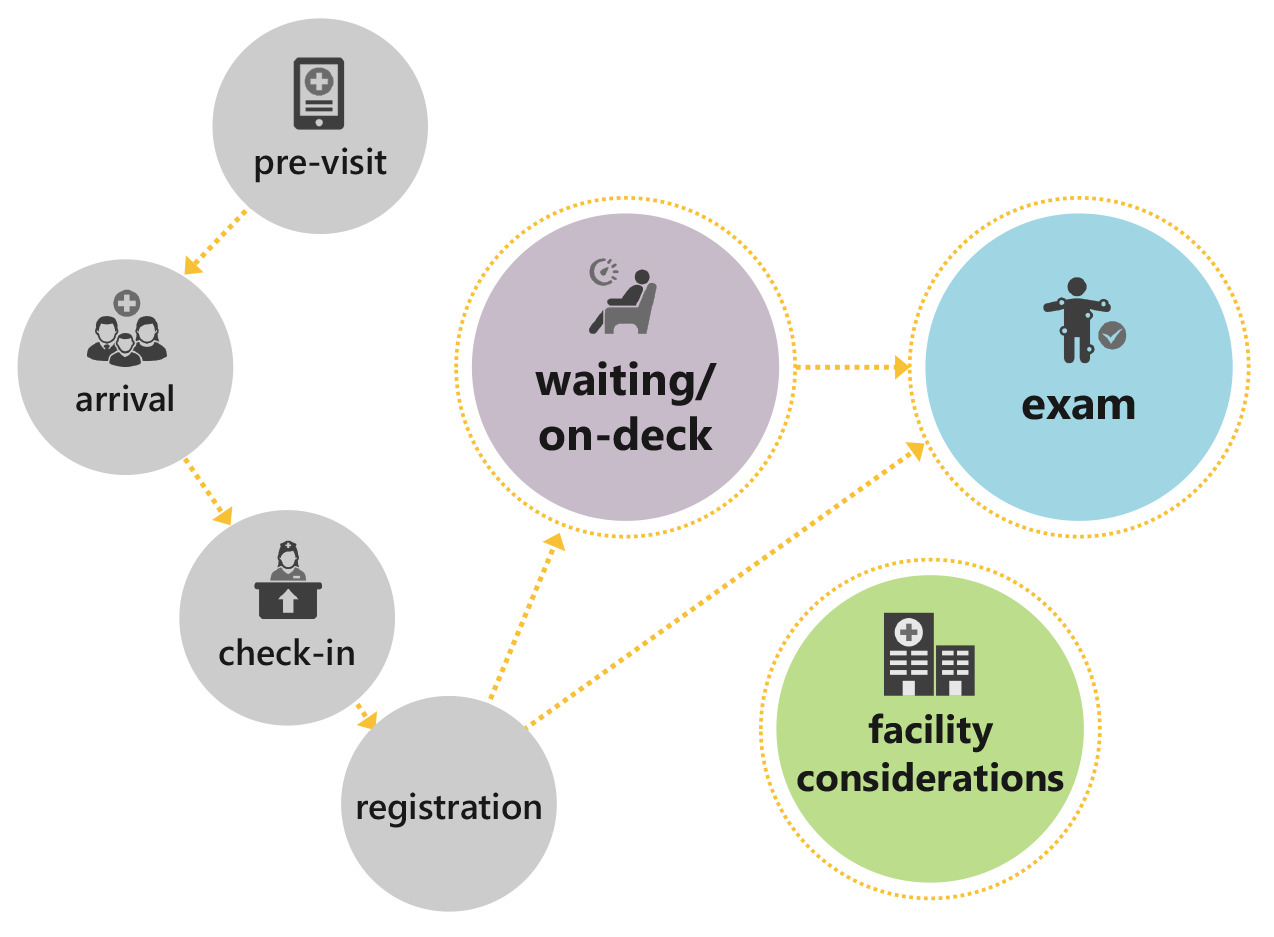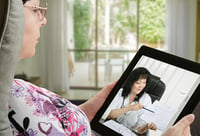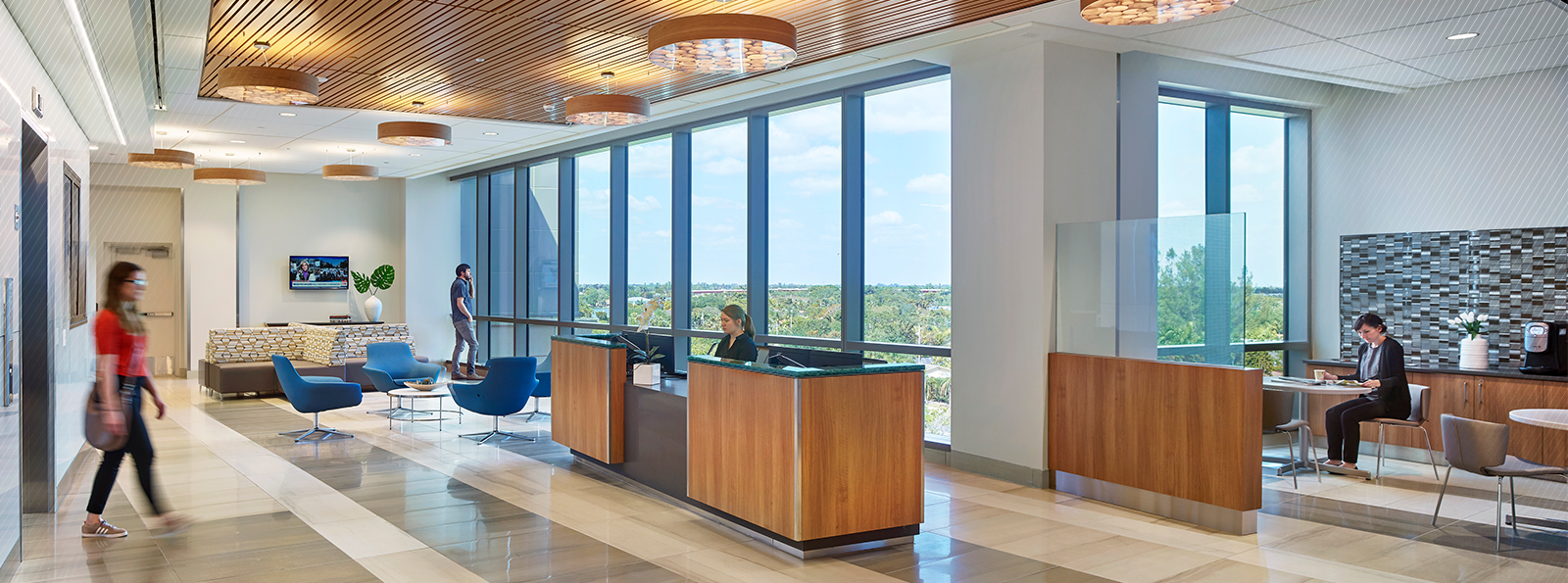First ran in HealthcareDesign Magazine, July 2020.
Stay-at-home orders and an intense focus on flattening the curve led many outpatient facilities to close their doors during the first few months of the COVID-19 pandemic.
Now, as many healthcare providers are resuming outpatient services and reopening their facilities, they need to address how to ameliorate patient anxiety while encouraging a resumption of important care.
Through a lens of operational and facility categories, we have developed a toolkit approach to help guide these conversations with clients and provide step-by-step guidelines across the patient journey. Our baseline parameters are to reduce infection risk, acknowledge and reduce patient and staff anxiety, and streamline patient throughput.
The Patient Journey

The toolkit
The following topic areas explore how to holistically apply the above principles in an outpatient care setting:
Pre-visit
![]() Pre-visit communication is step one and provides an opportunity to communicate safety precautions and offer vital guidance about the inherent risks of delaying care. By developing and implementing standard instruction reminders, providers have an opportunity to set patient expectations and reduce anxiety. The communication should speak to testing requirements prior to the visit, personal protective equipment (PPE) expectations during a visit, screening protocols upon arrival, guidance for support/family members accompanying the patient, and infection prevention measures.
Pre-visit communication is step one and provides an opportunity to communicate safety precautions and offer vital guidance about the inherent risks of delaying care. By developing and implementing standard instruction reminders, providers have an opportunity to set patient expectations and reduce anxiety. The communication should speak to testing requirements prior to the visit, personal protective equipment (PPE) expectations during a visit, screening protocols upon arrival, guidance for support/family members accompanying the patient, and infection prevention measures.
Additionally, scheduling appointments further apart will allow for immediate rooming after check-in to reduce the number of people waiting, free up more time for providers to assess the physical and emotional needs of their patients, and allow for more rigorous cleaning of exam rooms between visits.
Staff protocol
 Creation of a policy for pre-shift temperature and wellness checks should relieve some staff anxiety around peer interaction, as well. Consideration of how staff may need or want to change when arriving in the morning or before leaving to go home is important. Health leaders should also communicate expectations around scrubs versus street clothes, changing on-site, directional access (addressed using signage), and personal devices such as smartphones to imbue staff confidence. If patients suspected of COVID-19 will be seen in the clinic, PPE protocols must be in place for those encounters and appropriate space must be provided to don and doff, such as a staff-designated bathroom, where lockers can be added to store street clothes. In some practices where there may an excess of exam rooms due to lower patient volumes, an exam room could be taken out of commission and dedicated as a staff changing room.
Creation of a policy for pre-shift temperature and wellness checks should relieve some staff anxiety around peer interaction, as well. Consideration of how staff may need or want to change when arriving in the morning or before leaving to go home is important. Health leaders should also communicate expectations around scrubs versus street clothes, changing on-site, directional access (addressed using signage), and personal devices such as smartphones to imbue staff confidence. If patients suspected of COVID-19 will be seen in the clinic, PPE protocols must be in place for those encounters and appropriate space must be provided to don and doff, such as a staff-designated bathroom, where lockers can be added to store street clothes. In some practices where there may an excess of exam rooms due to lower patient volumes, an exam room could be taken out of commission and dedicated as a staff changing room.
Telehealth
 The use of telemedicine has been vital to the safe continuation of urgent and chronic outpatient care during COVID-19. Going forward, healthcare organizations should develop standard algorithms for determining which visits are appropriate to conduct via telehealth as well as which patients can be assessed by scheduling/clerical staff and which require review by a clinical team member for a telehealth visit.
The use of telemedicine has been vital to the safe continuation of urgent and chronic outpatient care during COVID-19. Going forward, healthcare organizations should develop standard algorithms for determining which visits are appropriate to conduct via telehealth as well as which patients can be assessed by scheduling/clerical staff and which require review by a clinical team member for a telehealth visit.
The physical footprint required for a successful telehealth consult in an outpatient setting is modest, with a desk, video-conferencing equipment, web access, and secure email capabilities. The space should be uncluttered to reduce distraction and set a professional tone. Neutral, matte finishes reduce glare and will help focus attention on the speaker. Camera placement should promote eye contact; lighting should be placed to minimize face shadows to promote personalized care; and visual and acoustic privacy are paramount and can be achieved by selecting an area with full-height acoustic partitions and, ideally, a door. If a private space isn’t available, the telehealth zone should be out of view of others to ensure privacy.
Arrival
In the era of COVID-19, creating a welcoming and stress-free setting is more important than ever, because patients and caregivers are legitimately worried about becoming infected during these visits. Starting at the entrance, discreet, contactless temperature scanning and clear cues for social distancing can support the perception of wellness and overall well-being and start to put patients’ minds at ease. The addition of directional travel signs and messaging on protocols for hand hygiene, masks, and surface cleaning are also advised, as these unfamiliar practices have the potential to dramatically increase patient stress levels. Adoption of a concierge model where a staff member may serve as a roving greeter to screen arriving patients, provide guidance for PPE and direct the check-in process and where to sit, and share next steps will likely be a much-appreciated courtesy.
Check-in
![]() A quick and streamlined check-in process will increase consumer confidence and satisfaction. Healthcare operators can leverage existing electronic medical record systems to launch and promote portal-based check-in modules located front-and-center of the entry point of the facility to reduce interactions with staff and queuing (depending on the geometry of the waiting space). To relieve concern about touching a screen, practices may include the use of unsharpened pencils with erasers to interact with the touchscreen as well as providing disinfecting wipes.
A quick and streamlined check-in process will increase consumer confidence and satisfaction. Healthcare operators can leverage existing electronic medical record systems to launch and promote portal-based check-in modules located front-and-center of the entry point of the facility to reduce interactions with staff and queuing (depending on the geometry of the waiting space). To relieve concern about touching a screen, practices may include the use of unsharpened pencils with erasers to interact with the touchscreen as well as providing disinfecting wipes.
Immediate rooming
By moving patients to exam rooms directly after check-in, the number of patients in common areas is reduced. If exam room capacity is not sufficient for immediate rooming for all patients, criteria should be developed for identifying special populations for this service (e.g., at-risk, immune suppressed, respiratory symptoms).
Waiting
![]() While reducing or even eliminating waiting is ideal, additional strategies should be considered to ensure safety and well-being. Removing elements from common spaces such as literature, toys, and water dispensers that promote the spread of infection via shared surfaces will decrease the burden of cleaning. Patients will feel more comfortable if waiting zones aren’t crowded, so designers can develop alternate seating arrangements and take out some furniture. The addition of freestanding screens can also help achieve separation and reinforce distance between patients.
While reducing or even eliminating waiting is ideal, additional strategies should be considered to ensure safety and well-being. Removing elements from common spaces such as literature, toys, and water dispensers that promote the spread of infection via shared surfaces will decrease the burden of cleaning. Patients will feel more comfortable if waiting zones aren’t crowded, so designers can develop alternate seating arrangements and take out some furniture. The addition of freestanding screens can also help achieve separation and reinforce distance between patients.
Exam/intake
![]() An efficient and effective point-of-care workflow will minimize unnecessary patient and staff movement. In support of that, room layout, sink placement, exam table placement, and the consultation zone will be essential considerations. Collection of vitals and confirmation of medication lists and symptoms in the exam room instead of an intake zone will reduce patient moves (and cleaning). The addition of waterless sanitizer dispensers on both sides of exam room doors will help prevent the spread of infection. Reduction of staff moves in and out of the exam room can be achieved by stocking the room for a full shift. To improve patient and staff safety during this stage in the patient journey, consider active and passive infection control interventions, including UV-light self-cleaning keyboards and the adjustment of water flow sensors on faucets to encourage proper handwashing duration. Finally, staff should have all necessary resources, including after-visit summary printouts, scheduling capability, and wellness/post-visit educational materials, to complete all check-out activities while still in the exam room.
An efficient and effective point-of-care workflow will minimize unnecessary patient and staff movement. In support of that, room layout, sink placement, exam table placement, and the consultation zone will be essential considerations. Collection of vitals and confirmation of medication lists and symptoms in the exam room instead of an intake zone will reduce patient moves (and cleaning). The addition of waterless sanitizer dispensers on both sides of exam room doors will help prevent the spread of infection. Reduction of staff moves in and out of the exam room can be achieved by stocking the room for a full shift. To improve patient and staff safety during this stage in the patient journey, consider active and passive infection control interventions, including UV-light self-cleaning keyboards and the adjustment of water flow sensors on faucets to encourage proper handwashing duration. Finally, staff should have all necessary resources, including after-visit summary printouts, scheduling capability, and wellness/post-visit educational materials, to complete all check-out activities while still in the exam room.
The path forward
Designers have a duty to work with their healthcare clients to reimagine the new normal in the outpatient setting. As we envision what that built environment will look like in the short, mid-, and long term of a COVID-19 world, we must address the very real risks of infection transmission in tandem with the psychosocial impact of experiencing our physical environments. In the process, we must not abandon our commitment to create environments that are welcoming and collaborative and promote healing and well-being.
Looking for more COVID-19 Resources? Visit our hub.

